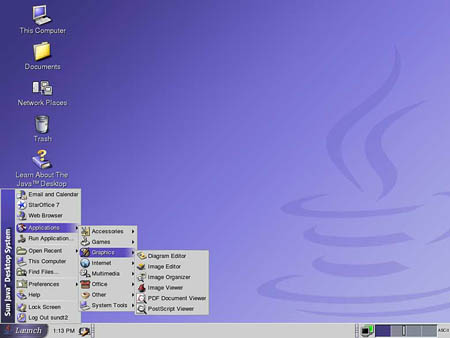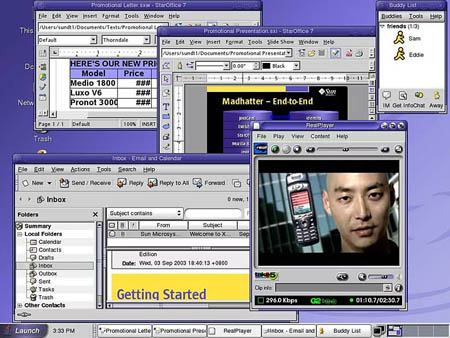Sun's W2100z Dual Opteron Workstation
by Kristopher Kubicki on October 27, 2004 12:05 AM EST- Posted in
- Systems
Sun Java Desktop System 2.0, SuSE Linux
By default, our w2100z does not come with any operating system. The Sun Java Desktop System would be the logical desktop for most to run on a Sun hardware platform. JDS is not exactly an operating system, but actually an alternative X desktop/environment to KDE or Gnome. You can check out more information about JDS here.Some JDS 2.0 applications are fairly dated, but that doesn't particularly mean that JDS is any less powerful. JDS revolves around Sun's StarOffice 7 suite on top of a modified GNOME desktop. RealPlayer, VNC, GAIM, Mozilla and Evolution are also integrated into JDS as well.
The similarities between the SuSE desktop and the JDS are very prevalent. We see the same YAST software manager and YOU online update - the only difference between YOU updates from a Sun repository instead of a SuSE one.
Sun also bundled the Looking Glass Project with our JDS desktop. Although just barely useable at this point, Looking Glass aims to be one of the first "true" 3-Dimensional desktops. Looking Glass feels a lot like the MacOS X desktop, allowing us to page through applications via a graphical list of icons in the middle of the screen. Of course, being Sun, there is a heavy dependence on Java and the only real applications that give us any additional features in Looking Glass are Java based. We will look more into Looking Glass as it evolves, but in the meantime, feel free to download the demos of the desktop from Sun's project page and the Java.net development page.
JDS's competitive edge over some other distributions mostly lays in its design, Sun designed JDS as an enterprise operating system and thus, workstation stability is paramount. Falling under Sun's corporate support wing is a plus, and the pricing certainly isn't bad either. JDS's nearest competitor, Ximian XD2, offers the OpenOffice suite instead of StarOffice, but costs $100 for full support.
JDS is still in its infancy. The fact that JDS does not support 64-bit Linux operation is disappointing, but it is not its downfall. In fact, for those who want a quick, simple desktop designed around StarOffice 7 (which usually costs $80 by itself), JDS is a very neat solution. Getting Sun's tech support resources for $50/year is a great deal for many users, but it comes free with our w2100z.












47 Comments
View All Comments
KristopherKubicki - Wednesday, October 27, 2004 - link
PrinceGaz: Multiple probes.Thanks for all the positive feedback!
Kristopher
slashbinslashbash - Wednesday, October 27, 2004 - link
#12, the Power Mac G5 is Apple's high-end workstation/server. The iMac is Apple's consumer-oriented product.I'd say that the PPC970 (G5) should be roughly comparable to an Opteron/Athlon64 at the same speeds -- at least much more comparable than a P4 at the same clock speeds. It's got a 16-stage integer pipeline, and the FPU units kick serious ass, especially with code that utilizes AltiVec (similar to SSE for x86). It's got a high-speed bus comparable to HyperTransport. AMD's integrated memory controller does give an advantage, but still I think the G5 could hang in there. Really though, any benchmark would come down to optimized code. Companies like Adobe and Apple that have the time, money, and inclination to optimize their applications for Apple hardware will see serious performance advantages over PC hardware. gcc-compiled apps, not so much, although more PPC-specific optimizations should come sooner or later.
Arstechnica has a very lengthy article on the PPC970 architecture. Take a look, if you have the time, and I don't think you'll walk away with a bad opinion of the G5.
BTW, I'm glad to see a Sun review here :) Interesting stuff. I would've liked to see another shot or two of the case itself, with all the components in it; plus a shot from the rear of the system. I'd like to see just how much space is in between that mezzanine card and the motherboard, and I'm kind of confused as to how the extender card fits in. It looks like it simply lies parallel with the motherboard (attaching along the bottom of the motherboard), but most of the time that there's a separate card, it is perpindicular.
thesix - Wednesday, October 27, 2004 - link
#12:"mlittl3 is attempting to compare a consumer product with a high end workstation/server."
You talk like a typical marketing person.
From pure HW design/layout point of view,
G5 _feels_ so much better than w2100z.
What makes me feel better with w2100z is the (new) Solairs OS and Opteron CPU.
Plus, I want to show support for both Sun and AMD :)
thesix - Wednesday, October 27, 2004 - link
I assume AMD CPUs/systems are faster. I haven't got a chance to do any serious testing between my dual-246 w2100z and my friend's dual-2.0GHz G5.I guess I simply don't care that much, anything less
than 10% of performance difference is not that significant to me. However, it's always good to know "my computer is faster than yours". :)
Reflex - Wednesday, October 27, 2004 - link
The problem with the recent Mac article appears to be that it has attracted the zealots to this site in force. mlittl3 is attempting to compare a consumer product with a high end workstation/server. They target different market segments and are designed for different tasks. Furthermore, the support offered for each, and the type of support is considerably different. Its Apples to Oranges.#11: We'll never really know how fast a G5 is in comparison, Apple does not allow independant hardware reviews, leaving it up to websites to purchase and test their own hardware. I know of no site as comprehensive as Anandtech on the Mac side of things as a result, so any claims of G5 performance are pretty much guesstimates and marketing unfortunatly. I wish this would change, it would be nice to know how Apple hardware really does perform as that would assist network admins in determining where it fits/if it fits into their current setup. Just being told by a company that "Its fast and stable" is not enough to make a corporation invest in a platform.
PrinceGaz - Wednesday, October 27, 2004 - link
Great review, the thermal graph is especially good in showing how the cooling performs. Did you attach many probes and take all the measurements in one go, or have to do it multiple times?----
The dual G5 uses some sort of liquid-cooling system inside the case I believe. That probably helps it reduce the noise.
Is a dual 2.5GHz G5 machine as fast as a dual Opteron 250 (2.4GHz) box anyway? Results posted by Apple themselves don't count of course :)
fic - Wednesday, October 27, 2004 - link
#8 you could replace the FX3000 with a 6800 and save another $1000.I would like to see a comparison between the w2100z and 2nd tier companies like Boxx, XI, Aspen, etc. I have been trying to talk my company into moving to a 2x 250 system from a 2x Xeon system to ship with our product. BTW, we do digital medical imaging and need the processing power to do image processing on our 4096x5625 images.
thesix - Wednesday, October 27, 2004 - link
I am surprised to see w2100z is rated as _quiet_ here. I _personally own_ w2100z for almost 3 months now, at home. Apple G5 is _much_ quieter than w2100z. In fact, noise is my biggest complain about w2100z, and I spent lots of time trying to "fix" it. I am confused.http://www.pbase.com/taochen/w2100z
mlittl3 - Wednesday, October 27, 2004 - link
Well, I guess all you apple-haters' comments that x86 computers are cheaper than apple computers can eat your words.Whitebox system $5284
Sun w23100z $8695
Apple Dual G5 2.5 GHz $5570
(configed with 4 GB RAM, larger 160 GB harddrive, Geforce 6800 which spanks the FX3000's ass and combo drive)
Oh that's right, you guys think the dual G5 system was meant for your grandmother to check email and your baby brother to play spongebob squarepants video games.
Get a clue. Good x86 systems with dual processors from reputable companies like Sun (or even whitebox systems) and dual apple systems cost about the same. Let's end at least the price part of apple vs x86 right here and now.
Araemo - Wednesday, October 27, 2004 - link
Wow.. you guys outdid yourselves, especially with the thermal graphs. I also want to say how nice it is to have a couple new reviews every week again. Keep up the good work guys. :)